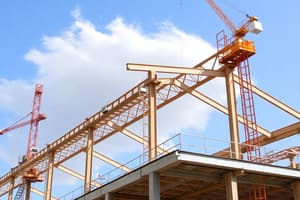Podcast
Questions and Answers
What is one of the two significant mechanisms that can lead to water being forced through walls and windows?
What is one of the two significant mechanisms that can lead to water being forced through walls and windows?
- Capillary action
- Pressure difference acting across a sealed joint (correct)
- Evaporation
- Thermal expansion
The kinetic energy of air-borne droplets in fast-moving air can prevent water from penetrating an open joint.
The kinetic energy of air-borne droplets in fast-moving air can prevent water from penetrating an open joint.
False (B)
What principle does cladding that is designed for pressure-equalisation rely on to manage water penetration risks?
What principle does cladding that is designed for pressure-equalisation rely on to manage water penetration risks?
Pressure equalisation
Water is forced through openings and joints by mechanisms such as pressure difference and the kinetic energy of __________ droplets.
Water is forced through openings and joints by mechanisms such as pressure difference and the kinetic energy of __________ droplets.
Match the following concepts to their descriptions:
Match the following concepts to their descriptions:
Which Technical Note discusses issues relating to wind loading on tall buildings?
Which Technical Note discusses issues relating to wind loading on tall buildings?
What is one of the primary functions of tiled roofs in relation to air flow?
What is one of the primary functions of tiled roofs in relation to air flow?
The wind pressure on the external face of the building remains completely constant over time.
The wind pressure on the external face of the building remains completely constant over time.
What two types of pressure management designs do modern rainscreen facades typically have?
What two types of pressure management designs do modern rainscreen facades typically have?
The analysis of the movement of air into and out of a cavity as a result of pressure variations is known as _____ movement.
The analysis of the movement of air into and out of a cavity as a result of pressure variations is known as _____ movement.
Which of the following methods can improve the effectiveness of preventing water penetration?
Which of the following methods can improve the effectiveness of preventing water penetration?
Match the following terms with their corresponding descriptions:
Match the following terms with their corresponding descriptions:
Overlapping joints between tiles can help minimize water penetration.
Overlapping joints between tiles can help minimize water penetration.
What is the primary purpose of the roofing felt beneath tile roofs?
What is the primary purpose of the roofing felt beneath tile roofs?
What occurs if the cavity compartments are sufficiently small?
What occurs if the cavity compartments are sufficiently small?
Positive external wind pressures occur only at the edges of a building.
Positive external wind pressures occur only at the edges of a building.
What does rapid pressure-equalization prevent in the cavity?
What does rapid pressure-equalization prevent in the cavity?
External wind pressures vary in magnitude from a peak positive pressure at the ______ face.
External wind pressures vary in magnitude from a peak positive pressure at the ______ face.
Match the following external wind effects with their descriptions:
Match the following external wind effects with their descriptions:
Why is cavity volume an important factor in pressure management?
Why is cavity volume an important factor in pressure management?
Air will always be drawn through non-compartmentalized cavities at a low velocity.
Air will always be drawn through non-compartmentalized cavities at a low velocity.
What is the primary risk associated with water penetration in rainscreen design?
What is the primary risk associated with water penetration in rainscreen design?
Flashcards are hidden until you start studying
Study Notes
Introduction to Pressure Equalisation
- Pressure-equalisation is crucial for managing water penetration through walls and windows in wind-loaded structures.
- Water can enter through joints via pressure differences or kinetic energy from moving air.
Mechanisms of Water Penetration
- A pressure difference across a closed joint can push water through.
- Fast-moving air can carry airborne droplets through open joints, necessitating well-constructed overlaps in cladding.
Cladding Constructed on Pressure Equalisation
- Pressure-equalisation cladding utilizes air cavities effectively sealed to prevent water penetration while allowing drainage.
- Ensuring cavity seals while allowing drainage at the bottom enhances effectiveness against water intrusion.
Wind Pressure Variation
- Wind pressures can vary significantly over short durations, often changing within 0.1 seconds.
- Building design must account for varying wind pressure, while structural safety factors typically involve a constant wind pressure.
Cavity Air Movement
- Positive and negative wind pressures affect adjacent building faces simultaneously, inducing airflow through non-compartmentalised cavities.
- Cavity design should ensure rapid equalisation of internal air pressure to prevent water ingress through joints.
Cavity Volume and Pressure Dynamics
- Small cavity compartments help equilibrate air pressure with external wind pressure, reducing the chance of water being drawn into the structure.
- Proper compartmentalisation is essential in maintaining pressure equalisation and minimizing potential water intrusion.
Rainscreen Facade Designs
- Modern rainscreen facades are either drained-and-ventilated or pressure-equalised to mitigate water ingress.
- Drained-and-ventilated designs incorporate openings for water drainage while maintaining air flow stability in cavities.
Key Design Principles
- Proper sealing of air cavities enhances performance against water penetration.
- The overall effectiveness of pressure-equalisation in cladding is improved with careful design and testing, as outlined in regulations and standards.
Studying That Suits You
Use AI to generate personalized quizzes and flashcards to suit your learning preferences.





